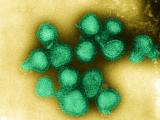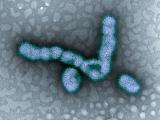Sep 15, 2009 (CIDRAP News) – A new study suggests that patients infected with pandemic H1N1 influenza can transmit the live virus longer than previously thought, though it's not clear if the findings will lead to changes in self-isolation recommendations.
Health officials have observed that the pandemic H1N1 virus behaves much like its seasonal counterparts and, in the absence of specific data on the new flu's shedding duration, have based many of their guidelines on staying home and then returning to activities on data for seasonal strains.
Initial recommendations were to stay home for 7 days after illness onset, though the US Centers for Disease Control and Prevention (CDC) recently modified its advice, urging patients to wait until they have been fever-free for 24 hours without the use of fever-reducing medication.
The Canadian researchers who conducted the study presented their findings today at the 49th annual Interscience Conference on Antimicrobial Agents and Chemotherapy (ICAAC) in San Francisco. Yesterday the lead author, Gaston De Serres, MD, from Laval University in Quebec, shared details of the study with journalists at a press conference that was streamed online.
Investigators evaluated the proportion of patients still shedding the pandemic H1N1 virus at day 8 of their illness. They tested nasopharyngeal swabs from 44 confirmed cases to determine the presence of influenza RNA by reverse transcriptase polymerase chain reaction (RT-PCR). They performed cultures on samples that were positive to assess the presence of replicating viruses.
They found that a week after flu onset, between 45% and 75% of cases still showed evidence of the virus on RT-PCR and that about a third were still shedding replicating virus based on culture findings.
Researchers concluded that the findings support a self-isolation period of at least 7 days but not longer than 10 days.
De Serres told reporters that it appears as if patients shed the pandemic H1N1 virus longer, but not much longer, than seasonal fu viruses. He said it's difficult to determine from the viral cultures how contagious patients still are longer than a week after illness onset.
In another study, presented at ICAAC yesterday, researchers from Singapore assessed the duration of viral shedding in 70 patients treated with oseltamivir (Tamiflu). They found that 47% shed the virus longer than 7 days and 8% shed the virus for longer than 10 days.
They concluded that prolonged shedding occurs despite oseltamivir treatment, though delayed treatment (later than 2 days after illness onset) did not prolong viral shedding.
Nancy Cox, MD, director of the CDC's influenza division, said current guidance balances the mildness of most novel H1N1 infections with the demands of work and school, the Associated Press (AP) reported today. She added that the virus is spreading so widely and quickly that more stringent isolation recommendations might not be as useful.
She said that though the studies suggest a longer shedding period, it's not clear if the later viral levels are enough to infect other people, the AP report said.
William Schaffner, MD, an immunization expert and chair of the Department of Preventive Medicine at Vanderbilt University in Nashville, told CIDRAP News that he doesn't anticipate that the findings will lead to any changes in self-isolation recommendations. "Everyone is pretty happy with what we're doing now," said Schaffner, who is secretary of the Infectious Diseases Society of America.
Attempts at social distancing are imperfect, but health officials are doing the best they can, he said. Experts believe patients shed the virus 24 hours before they get sick.
"So it's back to washing hands, and everyone needs to get vaccinated. These general themes apply to seasonal flu, too," Schaffner said.
See also:
ICAAC Web site
http://www.icaac.org


















